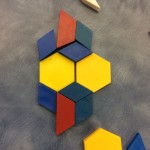As educators who have previously worked together on an EPCI project, we have enjoyed the opportunity to develop our own understanding of how young children learn mathematics. As educators, we span the ELK to Grade 2 classrooms and can work together to make connections to children’s learning. We felt that the connections between ELK to Grade 2 were important and warranted a continuum of learning through common experiences. Through collaborative inquiry learning, we engaged in conducting clinical interviews with our students that would further our own research and understanding of student spatial reasoning. This practice allowed us to provide meaningful opportunities for students to exercise their spatial reasoning abilities. We used games and math manipulatives to have our students work collaboratively and independently in problem-based situations. Our inquiry included co-learning in the classroom that would allow us to learn with and from each other and our students. By co-analysis of our clinical interviews, we gained insight into our students’ thinking and explored opportunities to push all of our students further and increased student achievement. We would also have liked some time to review professional reading such as Doug Clements research on spatial reasoning and those cited on TMERS website.
Team Members
Tracy Windover
Rainbow District School Board
Carole Burke
Rainbow District School Board
Shannon Lafrance
Rainbow DSB
Dallas Cappellani
Rainbow DSB
Professional Learning Goals
Through our professional reading about spatial reasoning, we were able to achieve our goal of increasing our own understanding of all the possibilities that spatial reasoning can be in the classroom setting. We became more confident in making connections of spatial reasoning to other areas of the mathematical curriculum, such as in number sense and having students gauge the reasonableness of their answers. Through our documentation, we were able to have evidence of students learning and a demonstration of improvements in their ability to use spatial reasoning skills in problem-solving situations.
Activities and Resources
To begin our inquiry, we elicited the help of some students from each grade (ELK-2) and conducted a clinical interview. The activity included providing the students with square tiles and asking them to make as many different shapes as they could using only five square tiles per shape. Each tile had to connect on one complete side (not corner to corner). This activity required the students to mentally flip and rotate the shapes in order to see if they had already made one that was the same as a previous one. (Paying Attention to Spatial Reasoning (K-2) Ontario Ministry Monograph.)
From there, we provided daily opportunities for students to engage in spatial awareness activities which included the use of manipulatives and iPad apps and paper and pencil tasks. Mental visualization activities were also promoted along with gesturing and kinesthetic activities.
Resources that we used included: Magnatiles, Megformer, Hexactly, Pentominoes, Swish, Q-bitz, Lego, Block Play, Pattern Blocks, Shape By Shape, Square By Square, Rush Hour and Puzzles.
Unexpected Challenges
Some of the challenges that we encountered were:
- time to ensure that target students were engaged in daily spatial reasoning activities
- measurement of success (knowing that it is the spatial reasoning activities that are improving the students’ mathematical achievement and not other factors, such as increased exposure to math activities in the classroom, mental math and maturity, etc.)
- entering the data in this website was very challenging as it indicated that the information was saved but would disappear when opening another page
Enhancing Student Learning and Development
Our students arrive at school with a variety of spatial reasoning abilities and understanding. By paying attention to spatial reasoning activities in our classroom, we were able to provide the opportunity to shape and help the children’s spatial reasoning grow. By providing these opportunities, we know that we are then supporting their learning in a variety of other areas such as in the arts, math, science and technology.
Sharing
We have shared our learning with our grade partners and at a staff meeting. Our target audience was other primary educators. Our forum is very informal and included providing hands-on learning experiences that our colleagues could use in their classroom.
Project Evaluation
Through our professional reading about spatial reasoning, we were able to achieve our goal of increasing our own understanding of all the possibilities that spatial reasoning can be in the classroom setting. We became more confident in making connections of spatial reasoning to other areas of the mathematical curriculum, such as in number sense and having students gauge the reasonableness of their answers. Through our documentation, we were able to have evidence of students learning and a demonstration of improvements in their ability to use spatial reasoning skills in problem-solving situations.
Resources Used
Sarama, Julie and Douglas H. Clements. Teaching Math in The Primary Grades: The Learning Trajectories Approach.
https://www.naeyc.org/files/yc/file/Primary_Interest_BTJ.pdf
LNS Monograph, Paying Attention to Spatial Reasoning.
Ehrlich, Stacy B., Susan C. Levine and Susan Goldin-Meadow, The Importance of Gesture in Children’s Spatial Reasoning, 2006.
http://spatiallearning.org/publications_pdfs/Ehrlich%20Levine%20%20Goldin-Meadow%20(2006).pdf
We also reviewed the following lesson studies on the M4YC website:
Geometry: Connecting 2D and 3D
Geometry: Spatial Reasoning and Orientation of 2D Shapes – See more at: http://tmerc.ca/m4yc/northumberland.html#sthash.0CGIoyic.dpuf
Resources Created
These resources will open in your browser in a new tab, or be downloaded to your computer.







